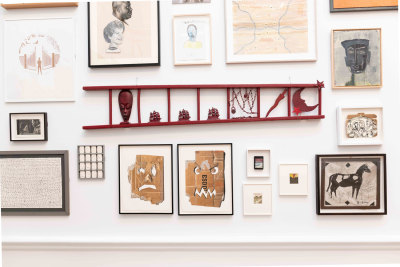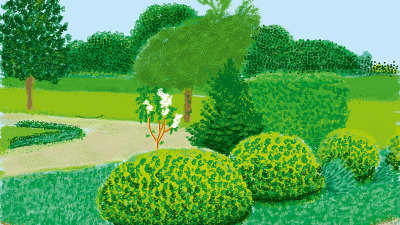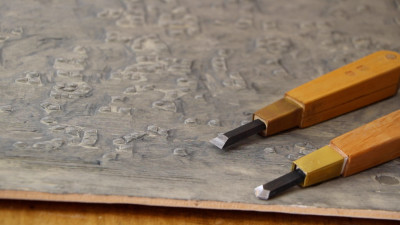10 game-changing art manifestos
10 game-changing art manifestos
By Harriet Baker
Published 10 April 2015
We’ve heard the party manifestos – now let’s take a look at the ones that shook up the art world, from Sir Joshua Reynolds to the Guerilla Girls.
-
Some time between 1966-76, Richard Diebenkorn wrote ten notes on beginning a painting. Described by the critic John Elderfield as a set of “artistic intentions,” they are a valuable insight into the mind of the artist, revealing some of the ways that Diebenkorn challenged himself in his work.
Diebenkorn, of course, was not the first artist to lay out his beliefs. From Joshua Reynolds’s lofty Discourses to the impassioned manifestos of the early 20th-century’s avant-garde, artists have laid out pages of their visions for art, many of which changed the course of art history. And while contemporary artists continue to set their objectives on paper, it is often done with a more wry and humorous touch.
The result is a collection of imperfect but fascinating ideas about what art should be. Here, let’s take a look at just a few of the great artist visions for a better world.
-
1. Discourses on Art, Sir Joshua Reynolds, 1769-1790
Sir Joshua Reynolds, the first President of the Royal Academy, delivered a series of lectures to the students of the RA Schools between 1769 and 1790. His Discourses on Art, now considered to be the founding text of British painting theory, elevated art as an activity of the mind, not the hand, and called on painters to imbue their work with much more than simply what they saw in front of them. The Discourses were very influential, but controversial too; William Blake annotated his copy furiously, noting his “indignation and resentment” at Reynolds’s ideas, while the Pre-Raphaelites accused Reynolds of ignoring the truth in favour of ideal beauty.I wished you to be persuaded, that success in your art depends almost entirely on your own industry; but the industry which I principally recommend, is not the industry of the hands, but of the mind… We may go so far as to assert, that a painter stands in need of more knowledge than is to be picked off his pallet, or collected by looking on his model, whether it be in life or in picture. He can never be a great artist, who is grossly illiterate… He ought to know something concerning the mind, as well as a great deal concerning the body of man.
Sir Joshua Reynolds PRA, Discourses VII, 1769
-

Sir Joshua Reynolds PRA, Self-portrait (detail), ca. 1780.
Oil on panel. Photo: © Royal Academy of Arts, London. Photographer: John Hammond.
-
2. The Founding and Manifesto of Futurism, FT Marinetti, 1909
Futurism was founded in Italy in 1909 and celebrated the advancement of technology and urban modernity, and a severance with the traditions of the past. Through multiple manifestos, written by the Italian philosopher and writer Filippo Tommaso Marinetti, the movement championed action over sentiment – drawing on the dynamism of machinery, speed and noise in both painting and cinema. The extract below is taken from the founding manifesto, published on the front page of the French newspaper Le Figaro on February 20, 1909. The first of the major avant-garde manifestos, texts by the Cubists, Dadaists (see below), Vorticists and Surrealists followed.1. We intend to sing the love of danger, the habit of energy and fearlessness.
2. Courage, boldness, and rebellion will be the essential elements in our poetry.
3. Up to now, literature has extolled a comtemplative stillness, rapture and reverie. We intend to glorify aggressive action, a restive wakefulness, life at the double, the slap and the punching fist.
F.T. Marinetti, 1909
-
3. Staatliche Bauhaus, Walter Gropius, 1919
Walter Gropius was a German architect who founded the Bauhaus movement in 1919, by merging two schools for applied and fine arts in the Weimar Republic – the University of Applied Arts in Vienna with the Saar College of Fine Arts in Saarbrücken, Germany. His aim was to found a school that would operate as a centre for industry and crafts, with teaching administered through practical workshops. Teachers included prominent artists such as Wassily Kandinsky and Paul Klee. The manifesto consisted of a four-page pamphlet printed in 1919, in which Gropius announced that in his school, architecture, sculpture and painting would return to craft.
Architects, sculptors, painters – we all must return to craftsmanship! For there is no such thing as “art by profession". There is no essential difference between the artist and the artisan. The artist is an exalted artisan.
Walter Gropius, 1919
-
4. Concerning the Spiritual in Art, Wassily Kandinsky, 1912
The Russian painter Wassily Kandinsky wrote this shortly after completing the watercolour Untitled, often considered to be the first ever abstract painting. Having progressed his work through early influences of Russian folk art and Post-Impressionism, he arrived at his colourful and emotive abstract works, informed by his belief in painting as an expression of the artist’s inner life. He outlines these ideas in this now famous text, written during his time with the group Der Blaue Reiter (Blue Rider). Central to his argument is the claim that seeing any given combination of colour and form will cause a particular “inner resonance" in the viewer. Later, during his years as a teacher at the Bauhaus, he famously issued students with a questionnaire asking them to instinctively match circle, square, triangle with red, yellow and blue. The fact that most of them got it “right” (yellow triangle, red square, blue circle) proved, he said, that there was a universal correspondence.
The mutual influence of form and colour now becomes clear. A yellow triangle, a blue circle, a green square, or a green triangle, a yellow circle, a blue square – all these are different and have different spiritual values.
Wassily Kandinsky, 1912
-
5. Dada manifesto, Tristan Tzara, 1918
Tristan Tzara was a French poet and essayist, famous for founding Dada in Zurich in 1916 and writing the founding manifesto. Spanning a wide variety of mediums and forms – from photography and performance art to painting and collage – the Dada movement was born out of a reaction against nationalism and rationalism, which these artists believed to have caused the First World War. Though the movement was far from coherent, its key figures – including Hans Arp, Kurt Schwitters and Hannah Hoch – produced highly political and irreverent works influenced by Cubism, Futurism and Constructivism.
A work of art is never beautiful by decree, objectively and for all. Hence criticism is useless, it exists only subjectively, for each man separately, without the slightest character of universality… Dada was born of a need for independence, of a distrust toward unity. Those who are with us preserve their freedom. We recognize no theory.
Tristan Tzara, 1918
-
-
6. Five Points Towards a New Architecture, Le Corbusier, 1926
Le Corbusier is now credited as a pioneer of modern architecture. His prefabricated housing, with its emphasis on open communal space and exterior facades free from structural constraint, were hugely influential in the re-building of French cities after the First World War. In his 1923 publication, Toward a New Architecture, he famously stated: “A house is a machine for living in.” This extract demonstrates his approach to uncomplicated modern buildings.The following points in no way relate to aesthetic fantasies or a striving for fashionable effects, but concern architectural facts that imply an entirely new kind of building, from the dwelling house to palatial edifices… The age of the architects is coming.
Le Corbusier, 1926

-
-
7. The Laws of Sculptors, Gilbert & George, 1967
Gilbert Proesch and George Passmore met at art school in 1967 and formed a partnership that has lasted for over 40 years. In work that tackles a myriad of social issues - including sex, religion, race, addiction and death - the artists often appear themselves as “living sculptures”, typically dressed in smart grey suits. Their overriding mantra is “Art for all”, a reaction against the intellectual and economical elitism of contemporary art. This wry extract is taken from the pair’s first manifesto of 1969, The Laws of Sculptors.
1. Always be smartly dressed, well groomed, relaxed, friendly, polite and in complete control.
2. Make the world believe in you and to pay heavily for this privilege.
3. Never worry, assess, discuss or criticize but remain quiet respectful and calm.
4. The Lord chisels still, so don’t leave your bench for long.
Gilbert & George, 1967
-

Gilbert & George, Singing Sculpture, 1991.
© Gilbert & George. Courtesy White Cube.
-
8. The Guerilla Girls, 1985-90
In 1984, a group of anonymous women, wearing gorilla masks, picketed the Museum of Modern Art in New York. MoMA was opening a show which purported to be a definitive survey of contemporary art, and yet out of the 169 artists featured in the show, only 13 were female. Since their inception, the group have worked to expose the under-representation of women in the art world by targeting galleries, art dealers and critics. Their manifesto comes in the form of their famous slogan artworks.
-
![Guerrilla Girls, [no title]](#)
Guerrilla Girls, [no title], 1985–90.
© courtesy www.guerrillagirls.com.
-
9. The Stuckist Manifesto, 1999
Established in 1999, the British group the The Stuckists proclaimed themselves to be “Against conceptualism, hedonism and the cult of the ego-artist.” The movement was formed by Billy Childish and Charles Thomson to celebrate and promote figurative painting in a reaction to the proliferation of conceptual art. Every year, the Stuckists famously demonstrate outside Tate Britain as the winner of the Turner Prize is announced.
1. Stuckism is the quest for authenticity.
2. Painting is the medium of self-discovery.
3. Stuckism proposes a model of art which is holistic.
4. Artists who don’t paint aren’t artists.
5. Art that has to be in a gallery to be art isn’t art.
The Stuckists, 1999
-
-

10. Red Alan's Manifesto, Grayson Perry RA, 2014
Grayson Perry RA once famously asserted, “I can be outrageous because the vice squad is never going to raid a pottery exhibition.” Through traditional craft – tapestry and ceramics – Perry explores a disparity between form and subject and chronicles contemporary life. In Red Alan’s Manifesto, created for the Royal Academy, Perry provides a witty riposte to some of art’s biggest issues, such as: Can anything be art? Who decides whether art is good or bad? The manifesto is written under the authorship of Red Alan, a ceramic sculpture of his childhood teddy bear, Alan Measles.Nothing in art is new or old fashioned, only good or bad.
Grayson Perry RA, 2014
-
-
-

RA250 memberships
Be part of our anniversary – and support the next 250 years of art and artists
To celebrate our 250th birthday in 2018, we are offering limited edition memberships – giving you the opportunity to get closer to the New Royal Academy of Arts and our expanded programme.
-



![Guerrilla Girls, [no title]](https://d1inegp6v2yuxm.cloudfront.net/royal-academy/image/upload/c_limit,cs_tinysrgb,dn_72,dpr_auto,f_auto,fl_progressive.keep_iptc,w_950/rkzbc1tgwu8987rcxmrf.jpg)





